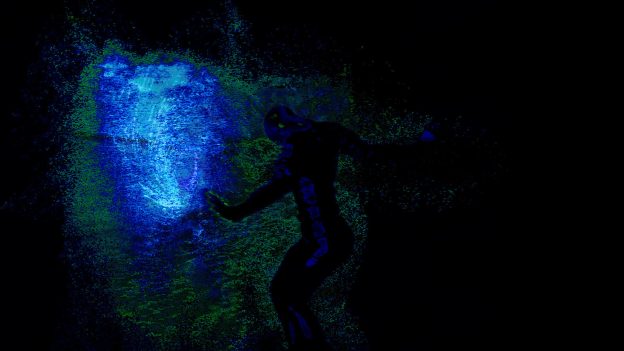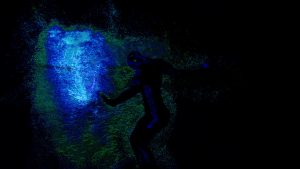with MOVEMENT PORTRAITS
from THE BLACK MOVEMENT PROJECT
by LAJUNÉ MCMILLIAN
Renaldo Maurice
FEW UNDERSTAND
An on-chain micro autofiction series by Kalen Iwamoto
Block 0 [Genesis block]
7 January, 2021
The atmosphere in our house during the Christmas holidays was lively and boisterous, laced with something heavy and sinister that nobody talked about. But with the new year, the unease gave way to a sense of optimism and renewal, and I deemed it safe to end the news detox I’d instated to keep anxiety at bay. So, on January 7, I sat down to read the news. The day’s headline in the New York Times read, “Trump incites mob. Rampage in Capitol forces evacuations; It’s ‘part of his legacy,’ a Republican says”. Below it, there was a photo of rioters scaling the wall, about to storm the Capitol. At that moment, the sinister thing cracked open and I was ambushed by the kind of dread that takes hold of an arachnophobe watching a spider egg hatch.
Is this the end or the beginning?
Block 1
11 January, 2021
Is this the end or the beginning?
This is what I ask myself at every big turn in my life — a breakup, a move to a new city, marriage, childbirth — as I fall into the gap that opens up between the end of one thing and the beginning of the next. In that liminal space, that vertiginous moment between identities, just for a moment, I am untethered. This is always both exhilarating and terrifying. For a brief moment, I can glimpse the seams and the hand at work, stitching my life together. I witnessed this while waiting for contractions after my water broke. I witnessed this on the train to Paris when I was leaving Amsterdam for good.
Block 2
22 January, 2021
I witnessed this on the train to Paris when I was leaving Amsterdam for good. I was newly single, glad to be leaving the Dutchman and the city that scorned tourists and expats alike. In the four-seater compartment of my getaway Thalys, there was a young couple sitting across from me. They were both slouched in their seats, looking down at their phones. Leaning slightly away from each other, they wordlessly scrolled with one hand, while the other lay between them, interlocked. I looked down at my book but my eyes were having trouble tracking the words. I sensed an intense, noiseless struggle in the periphery of my vision and looked up at the couple’s locked hands. They were playing thumb war.
Maybe it’s true what they say about millennials.
Block 3
4 March, 2021
Maybe it’s true what they say about millennials. As a borderline millennial, I’ve sometimes wondered whether the facile portrayal of our generation as lazy, entitled, multitasking brats could also be ascribed to me. Lazy? There was a time when I lacked the courage to pursue, or even name, what I truly wanted, and this translated into a listlessness that some might call laziness. Entitled? Don’t we all deserve the best in life? Multitasker? I used to be incapable of this, but now I do toddler-weighted leg lifts while stirring the blanquette de veau with a baby on my hip, wondering if maybe Sheila Heti wasn’t onto something. But surely not a brat? Maybe not, but I will say this. I have known the deep frustration of being given things in lieu of love.
Block 4
8 March, 2021
I have known the deep frustration of being given things in lieu of love. I remember, one evening, waiting in the snow in Vancouver, my bare legs shivering under my skirt. By the time his car finally pulled up, hours had passed. I slid into the back seat without a word and he hurried to apologize. His remorse thawed my indignation and I cried all the way home. He, on whom I depended for my safety and survival, had forgotten about me. Now I know that kind of dependence can be hard to bear. It’s not easy being a dad.
Block 5
19 March, 2021
It’s not easy being a dad. Especially when you have to deal with the daily hurdles and routine injustices that come with being an immigrant. My father is impassive on a normal day, brash and disagreeable when provoked, what one could call a stereotypical Asian patriarch. He was the child of poor Korean immigrants in postwar Japan and spent his days helping his family sift through the debris of war in search of scraps of metal to sell. He never talks about his past, but I’m certain that the cruelty he endured as a Korean boy in that time and place toughened him into the bully he later became and stunted his natural sensitivity and acute receptiveness to beauty. He once told me he dreamed of being the kind of person who could tell the difference between art nouveau and art deco.
Block 6
26 March, 2021
He once told me he dreamed of being the kind of person who could tell the difference between art nouveau and art deco. The comment made me think of Paris and the time I lunched at the bustling Bouillon Chartier, where the wine was cheap and the diners merry. Across the room, I saw an old man sitting alone amidst the swirling waiters. I was drawn to his stillness, how untouched he seemed by the din of clinking tableware and the guffaws erupting all around him. From the corner of my eye, I watched him as he ate his steak and fries and sipped his wine. My gaze traveled down, and I saw his shoes on the floor with the socks tucked neatly inside. His feet were bare under the table.
Block 7
2 April, 2021
His feet were bare under the table. So were the feet of many of the kids in the class. In this ramshackle classroom on the wrong side of the tracks in bustling Accra, I spent my afternoons with children from destitute families. As my time at the school drew near, I announced that I would be taking photos of each of them on the last day of school. When the day arrived, the children paraded into the classroom in full regalia — puffy floral dresses, crisp school uniforms, traditional kente attire — and when I pointed the camera at them, one by one, they struck theatrical poses. When I was done, a young boy named Kwesi grabbed my arm and led me outside the school, where his mother was waiting. She pressed into my hand a small bundle of kelewele, which she cooked and sold on the street. She asked me to take a photo of her.
Block 8
9 April, 2021
She asked me to take a photo of her. Flanked by my sisters, she leaned on the café table and cupped her face in her hands. Tilting her face at its most flattering angle, she smiled demurely at the camera, visibly practiced in the art of posing. My mother was middle-aged then, and her looks had withered due to a lack of attention, the passing of time and the ordinary troubles of life and her imagination. But when she was a young, my mother was beautiful, stylish and inordinately proud. She used to work at a department store in Japan, and one day, her boss asked her to model for their catalogue. She always acted like this was no big deal, but my father assured us that she had held on to the catalogue, which was buried away in a secret corner of her closet. I wonder if she ever looks at it.
Nala Duma
Block 9
18 April, 2021
I wonder if she ever looks at it. She found it in the sock drawer of her recently divorced linguistics professor, 20 years her senior, with whom she was having a fling the summer of our graduating year. It was a photo of his ex-wife with a cutout of his own eyes taped over hers. She tore it out of his journal and brought it to my apartment later that day. She’d insisted from day one that she’d never fall in love with him, but she kept gazing at the photo and asking me what I thought it meant. I looked at the photo, then at her, and shrugged. We’ve all done crazy things for love.
Block 10
14 May, 2021
We’ve all done crazy things for love. My first love was a beautiful, half-Japanese bad boy from the postwar Balkans with a jaded and weary outlook on life. He clung to the idea of me and my sheltered innocence, and loved me for living in a world he couldn’t believe in anymore. When we broke up, I dated around his absence for the rest of my young adulthood, seeking in every potential flame something of him — his sad eyes, his broken nose, his demeanour, his gait, his hands, his intensity, the way he touched me, the way he loved me. I kept exploring the memory of him in other men until 8 years after our breakup, when I got an email from him, asking for my forgiveness. It set me free.
Block 11
16 June, 2021
It set me free. That first night of freedom, I spent alone in my new apartment in Paris’ Latin Quarter, a 100 ft² chambre de bonne — a maid’s room, once upon a time. I lay on my mattress and studied the mottled stains that had bloomed on the ceiling, and eventually, fell asleep to the uninterrupted hum of the water heater, punctuated by Friday night revelries from the bar-filled streets below. The next morning, I awoke to the peal of church bells, and it felt quaint and idyllic to my North American ears. I got up, shuffled the half step to the small oeil-de-boeuf window and looked out onto Paris’ iconic zinc rooftops and the hundreds of chimney pots staccatoed against the sky. I stood there for a long time.
Block 12
4 August, 2021
I stood there for a long time. I had been scanning Marie Vassilieff’s Wikipedia page, and gasped at what I discovered. She was a fascinating multifaceted artist, whose Montparnasse atelier was a major hub for the greatest artists of the Ecole de Paris: Picasso, Modigliani, Léger, Matisse, Soutine… Later, to keep her struggling foreign artist friends from starving during the war, she opened her famous canteen, where people would come for sustenance and camaraderie.
What was her Madonna doing in this flea market, deep in the French hinterland? I ran back to the stall where my husband stood, still holding the framed collage of the Virgin Mary and dove. On the bottom right corner, the date 1931 and Vassilieff’s signature.
“Get it!” I panted.
He held up the framed artwork to the stall’s vendor. “How much for this, monsieur?”
“That frame’s old-fashioned, but in good condition. 1 euro.”
THE BLACK MOVEMENT PROJECT
In the past few years, access to motion capture data, 3D base models, and software to “make an animation of yourself” has skyrocketed. From MakeHuman to Mixamo to CMU’s motion capture database, the ability to make and finish polished projects has become easier for many. While these resources are extremely helpful to create a range of projects, they lack tools to create diverse characters and movements unexplored by systems that center assumptions of neutrality. When looking for culturally specific movements in existing motion capture databases, you may find some, but are often met with dances and movements that don’t reflect the search terms.
Also, in the name of making it “easy to use,” these tools often omit valuable information from users, including information about the motion capture actor who provided the movements, and important historical and cultural information about the movements performed. In 2018, lawsuits were filed against Fortnite for using dances from mainly Black creators without permission, compensation, or credit. The “Milly Rock” became “Swipe it,” and the “Carlton” became “Fresh,” effectively erasing the origins of these dances. Currently the lawsuits are on pause, because the dances are not considered choreography under copyright law.
How do we combat the erasure, dilution, and exploitation of Black culture and people? How can we discover, learn, invest in, and steward systems that prioritize liberation and abundance? The Black Movement Library (BML) is a library for activists, performers, and artists to create diverse XR projects, a space to research how and why we move, and an archive of Black existence. BML seeks to grow community through the use of performances, XR experiences, workshops, conversations, and tool making.
BML includes an online database of Black motion capture data and Black character base models. “Movement Portraits” serve as a way to learn about the lives of performers contributing their movement data to the database. What happens when we ritualize the archival process of data collection, and invite the community as a witness?
Using motion capture and Unreal Engine, performers send their movement data to be translated into visuals in real-time. Each experience ranges from five to ten minutes. The first Movement Portraits feature Nala Duma and Renaldo Maurice. Over the course of development, interviews are recorded with each performer, learning their movement histories. Interviews are embedded into soundscapes that performers move to, allowing the audience to dive into their lives and learn how Black movement has been used as a tool for the preservation of Black culture, as well as a vehicle of self-evolution.
While Movement Portraits are a real-time motion capture performance, they are also translated and archived as VR and single-channel video experiences. This allows movement to be re-represented as an abstract digital memory of the performance day.
Black movement does not only represent our individual experiences, but it also represents our collective memory, transcending space, time, and oppressive social structures. It allows us to connect to each other, our ancestors, our deepest selves, and gives us space to communicate to our future. Black movement is a technology, holding the stories of our existence across the Diaspora. Our bodies and movements are MORE than data points and avatars. They hold our humanity. It is time for digital spaces and tools to reflect that. It’s time for ALL spaces we enter to reflect that.
– LaJuné McMillian
KALEN IWAMOTO writer
Kalen Iwamoto is a translator, crypto writer, and artist based in France. Her crypto-native conceptual writing takes blockchain technology and crypto culture as its point of departure, and focuses on play and exploration to push the boundaries of the NFT medium.
Few Understand is a chain of micro autofiction stories that is structured like the blockchain—the last sentence in one block becomes the first sentence in the next. It is her first series on the Ethereum blockchain.
LAJUNÉ MCMILLIAN artist
LaJuné McMillian is a new media artist and educator, creating art that integrates performance, extended reality, and physical computing to question our current forms of communication. They are passionate about discovering, learning, manifesting, and stewarding spaces for liberated Black realities and the Black imagination. LaJuné believes in making by diving into, navigating, critiquing, and breaking systems and technologies that uphold systemic injustices to de-commodify our bodies, undo our indoctrination, and make room for different ways of being.
LaJuné has had the opportunity to show and speak about their work at Pioneer Works, National Sawdust, Leaders in Software and Art, Creative Tech Week, and Art && Code’s Weird Reality. LaJuné was previously the director of skating at Figure Skating in Harlem, where they integrated STEAM and figure skating to teach girls of color about movement and technology. They have continued their research on Blackness, movement, and technology during residencies and fellowships at the Jerome Hill Artist Fellowship, Eyebeam, Pioneer Works, Barbarian Group, and Barnard College.
© Copyright for all texts published in Stillpoint Magazine are held by the authors thereof, and for all visual artworks by the visual artists thereof, effective from the year of publication. Stillpoint Magazine holds copyright to all additional images, branding, design and supplementary texts across stillpointmag.org as well as in additional social media profiles, digital platforms and print materials. All rights reserved.



